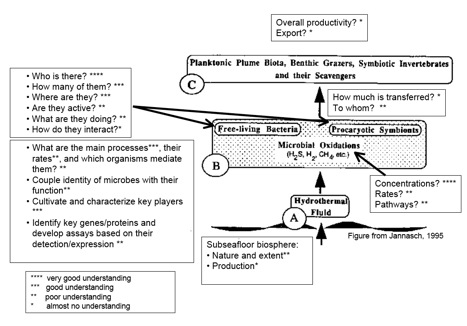Sievert
An Integrated Approach to Study Chemolithoautotrophic Processes at Deep-Sea Hydrothermal Vents at 9ºN, East Pacific Rise
S. Sievert¹*, C. Taylor¹, R. Summons², S. Schuster³, N. Le Bris⁴, L. Gulmann¹, S. Molyneaux¹, K. Richberg¹, & S. Sylva¹
Corresponding author: ssievert@whoi.edu
¹Woods Hole Oceanographic Institution, Woods Hole, MA, USA
²Massachusetts Institute of Technology, Cambridge, MA, USA
³The Pennsylvania State University, University Park, PA, USA
⁴IFREMER, Brest, France
Abstract:
At deep-sea vents, chemolithoautotrophic microbes mediate the transfer of energy from the geothermal source to the higher trophic levels. These organisms acquire energy from the oxidation of reduced inorganic compounds and are able to fix inorganic carbon, providing a continuous supply of organic carbon for heterotrophs and higher trophic levels. However, presently our knowledge on the identity and activity of these microorganisms at vents is inadequate. To address the question of how much carbon is produced in diffuse flow areas and to determine which organisms are responsible for it, we are pursuing a multifaceted approach combining analytical chemistry, isotopic analysis, microbiological methods, and genomic approaches. We have focused our efforts on two diffuse flow vent sites at 9ºN EPR that differ in physicochemical conditions. Metagenomic analyses indicate that oxidation of reduced S-compounds coupled to either oxygen or nitrate reduction are the predominant pathways for energy generation at these two sites, with some site specific differences that might be attributable to differences in physicochemical conditions. To further gain insights into which microbes are actively performing autotrophic production and to obtain rates of carbon fixation, shipboard incubations utilizing ¹⁴C- and ¹³C-labelled bicarbonate under varying conditions were performed. At both sites, highest carbon fixation rates were found close to the in situ temperature. However, significant activity was still observed at 70ºC, indicating the presence of organisms that might perform carbon fixation at elevated temperatures in the subseafloor. Analyses to identify autotrophic microorganisms more directly by using stable isotope probing for lipids and nucleic acids are ongoing. Furthermore, we are also studying the microbial colonization and subsequent succession of newly exposed surfaces in collaboration with others (e.g., Beaulieu, Ding, Luther, Seyfried, Shank, Vetriani). We have conducted one of the first studies on short-time scales (4-293 days) to look at initial microbial colonization in the context of vent chemistry, with some intriguing results.
Keywords:
9ºN EPR, subseafloor biosphere, carbon fixation, metagenome, stable-isotope probing
Contributions to Integration and Synthesis:
While we have made significant progress in assessing the extent of microbial diversity at deep-sea vents, our understanding of the functioning of these microbially-driven ecosystems is clearly lacking behind. Our data will help narrowing this gap by providing a comprehensive assessment of autotrophic processes and the controlling factors at a particular vent site. Thus, our study can be seen as a case study that will provide important information and input parameters for modeling efforts to arrive at a more global assessment of chemoautotrophic carbon production. At this point integration with geochemical datasets appears to be most promising to achieve this goal. A critical gap remains the lack of data on diffuse venting rates. There are also efforts underway by other PIs to obtain similar information at other vent ISS sites. By comparing emerging datasets, we will be able to better understand differences and similarities between vent sites, which ultimately will result in a more thorough understanding of chemoautotrophic production and its controls. Our data will also contribute to better define the extent and nature of the subsurface biosphere, which remains one of the least understood components of deep-sea hydrothermal vent ecosystems. Lastly, our data on microbial colonization and succession can be integrated with information on faunal community members as well as geological and geochemical data, contributing to a more holistic view of how biological communities respond to perturbations, such as volcanic eruptions.
Figures:
Figure 1. Summary of our current understanding of microbial communities and microbially mediated processes at deep-sea vents Sievert_fig1.jpg

